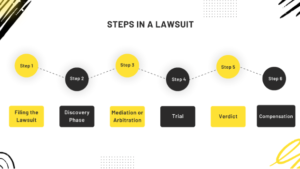A Step-by-Step Guide to Filing a Personal Injury Claim

Life can change in a matter of seconds when an accident occurs. Whether it’s a car crash, a slip and fall, or any other injury caused by someone else’s negligence, the aftermath can be overwhelming. If you’ve suffered a personal injury, knowing your rights and how to file a claim can make a huge difference in getting the compensation you deserve.
In this guide, we’ll walk you through the process step by step in a clear, easy-to-understand way. By the end, you’ll feel more confident in your ability to take action.
Step 1: Seek Medical Attention Immediately
The first step after any accident is to prioritize your health. Even if you don’t feel hurt right away, some injuries like whiplash or internal bleeding might not show symptoms until days or even weeks after the accident.
By getting checked out by a medical professional, you not only ensure your well-being but also create medical records that are crucial when it comes to proving your injuries later on. Keep copies of all your medical bills, prescriptions, and treatment recommendations; these will help build your case.
Why Medical Records Matter
Medical records are important because they:
- Serve as proof that the injury occurred and that it is related to the accident.
- Show the extent of your injury and the treatment needed, which can affect the value of your claim.
- Help establish a timeline that connects the accident to the injuries.
Step 2: Gather Evidence from the Accident Scene
The more evidence you can collect, the stronger your claim will be. If possible, document everything related to the accident while it’s still fresh in your mind. This includes taking photos and videos, obtaining witness contact information, and writing down your account of what happened.
Types of Evidence to Collect:
- Photos: Take pictures of your injuries, the accident scene, any property damage, and anything else that could be relevant (e.g., broken stairs, skid marks on the road).
- Witnesses: If there were witnesses to the accident, ask for their contact information. They might provide valuable testimony if your case goes to court.
- Police Reports: For car accidents or other incidents where law enforcement was involved, a police report can be a key piece of evidence in your claim.
For those involved in a car accident, contacting a car accident personal injury lawyer may help you navigate the complexities of your case. These lawyers are well-versed in traffic laws and insurance negotiations, making it easier to build a solid case.
Step 3: Consult a Personal Injury Lawyer
While it’s possible to handle a personal injury claim on your own, having a personal injury attorney can increase your chances of receiving full compensation. An attorney will understand the legal process, know how to negotiate with insurance companies, and be prepared to take your case to trial if needed.
If you’ve been injured in Norfolk, the first step is to seek medical attention and document your injuries, as this is critical for building your case. Next, gather evidence, including photos, witness statements, and any relevant documents, to support your claim. It’s advisable to consult with a personal injury lawyer norfolk to guide you through the legal aspects, from filing the claim to negotiating with insurance companies.
What a Lawyer Can Do for You:
- Help gather additional evidence and build a strong case.
- Calculate the full value of your claim, considering all of your losses, including future medical costs and lost earning potential.
- Negotiate on your behalf to get the best possible settlement.
Many personal injury lawyers offer a personal injury consultation for free, giving you the opportunity to discuss your case and get a sense of your options before committing to legal action.
Step 4: File a Claim with the Insurance Company
Once you’ve gathered evidence, it’s time to notify the at-fault party and their insurance company about your injury. This could involve a driver’s auto insurance, a property owner’s liability insurance, or another responsible party’s insurer, depending on your case.
When you file an insurance claim, make sure to:
- Be polite and factual.
- Provide only basic information (e.g., where and when the accident occurred).
- Avoid admitting fault or downplaying your injuries.
Why You Should Be Cautious with Insurance Companies
Insurance adjusters are trained to save their companies money, which means they may try to offer a low settlement or find ways to minimize your claim. You don’t have to accept the first offer, and you have the right to negotiate for a fair settlement.
Step 5: Determine the Value of Your Claim
To file a successful claim, you’ll need to determine how much compensation to ask for. The value of your claim will depend on several factors, including:
- Medical bills (both current and future costs related to the injury)
- Lost wages (if you were unable to work)
- Property damage (such as vehicle repairs in a car accident)
- Pain and suffering (compensation for physical and emotional distress)
An attorney can help you calculate these damages, ensuring that you ask for an appropriate amount in your claim. For example, if you were involved in a slip and fall accident, working with slip and fall lawyers personal injury could help you understand the specific details of such cases and ensure your claim covers all necessary expenses.
Step 6: Negotiating a Settlement
After you’ve filed your claim, the insurance company may come back with an initial settlement offer. It’s important to understand that the first offer is often lower than what you deserve. Don’t be afraid to reject it and negotiate for a better amount.
Key Steps in Negotiation:
- Respond to the insurance company’s offer with a counteroffer that reflects the full value of your claim.
- Be patient; negotiations can take time. The insurance company might use delay tactics to pressure you into accepting less.
- Be ready to present evidence that supports your claim, such as medical records, photos, and witness statements.
If negotiations are successful, both parties will agree to a settlement amount, and you’ll receive compensation without going to court. If negotiations fail, your lawyer may advise filing a lawsuit.
Step 7: Filing a Lawsuit (If Necessary)
If a fair settlement can’t be reached through negotiation, you may need to file a lawsuit and take the matter to court. In this case, your lawyer will file a formal complaint, and the legal process will begin.
Steps in a Lawsuit:

While most personal injury cases settle before trial, it’s essential to be prepared for the possibility.
FAQs
How long does a personal injury lawsuit take?
Personal injury lawsuits typically take anywhere from several months to a few years, depending on complexity, court availability, and whether a settlement is reached before trial.
What compensation can I receive in a personal injury claim?
You can recover compensation for medical bills, lost wages, property damage, pain and suffering, and sometimes punitive damages, depending on the severity of the injury and case circumstances.
Do I need a lawyer for a personal injury claim?
While not mandatory, a personal injury lawyer can greatly increase your chances of receiving fair compensation by handling negotiations and legal proceedings effectively.
Conclusion
Filing a personal injury claim can seem like a daunting process, but breaking it down into clear steps makes it much more manageable. By taking immediate action, gathering evidence, and seeking legal advice when needed, you can improve your chances of receiving the compensation you deserve.
Remember, every personal injury case is unique, and working with a trusted lawyer can help guide you through the process.


